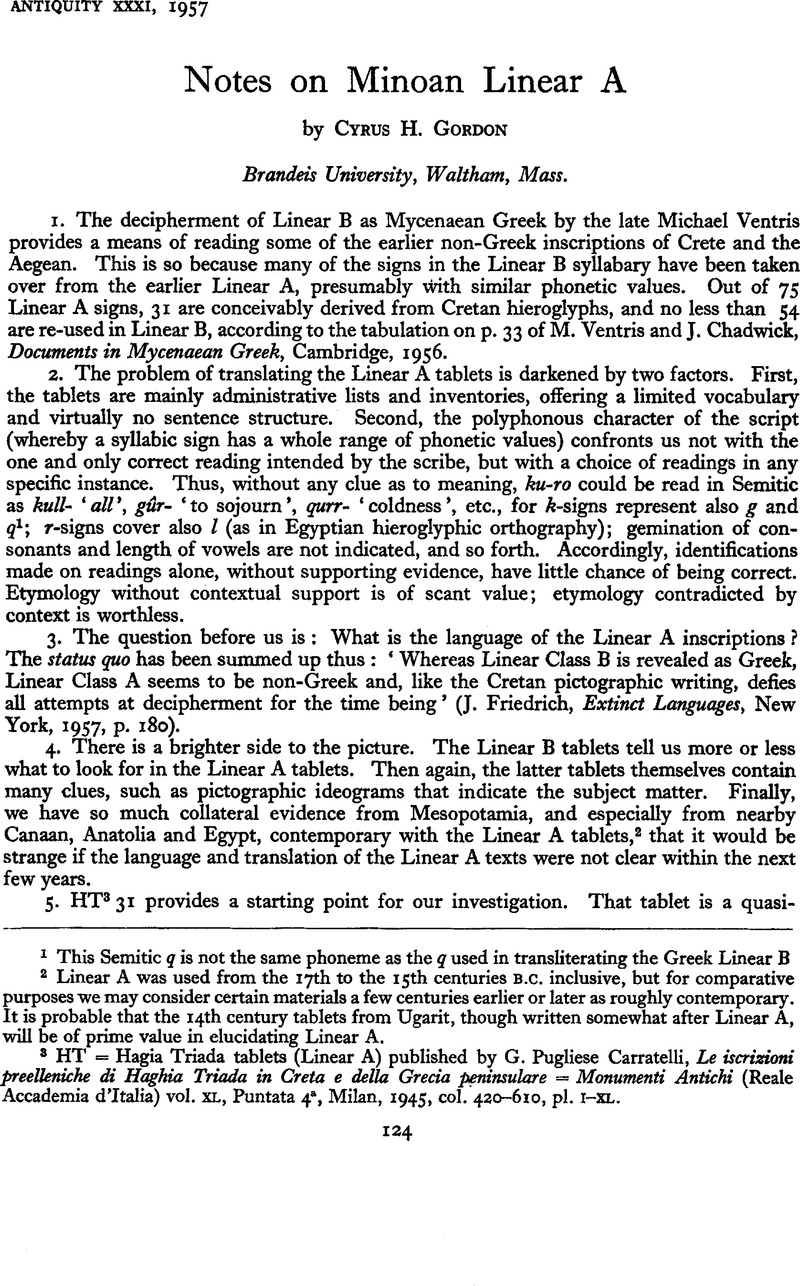Article contents
Notes on Minoan Linear A
Published online by Cambridge University Press: 02 January 2015
Abstract

- Type
- Articles
- Information
- Copyright
- Copyright © Antiquity Publications Ltd 1957
References
1 This Semitic q is not the same phoneme as the q used in transliterating the Greek Linear B
2 Linear A was used from the 17th to the 15th centuries B.C. inclusive, but for comparative purposes we may consider certain materials a few centuries earlier or later as roughly contemporary. It is probable that the 14th century tablets from Ugarit, though written somewhat after Linear A, will be of prime value in elucidating Linear A.
3 HT = Hagia Triada tablets (Linear A) published by G. Pugliese Carratelli, Le iscrizioni preelleniche di Haghia Triada in Creta e della Grecia peninsulare = Monumenti Antichi (Reale Accademia d’Italia) vol. XL, Puntata 4a Milan, 1945, col. 420-610, pl. I-XL.
4 H. Gordon, Ugaritic Manual, Rome, 1955.
5 See UM §20.971 for the Akkadian cognate, too.
6 ‘Caphtor’ is used in Ugaritic, the Old Testament and many other Near Eastern sources for the Aegean World, of which Crete was the hub.
6a Genesis 6 : 3 ; Judges 5 :7. Since ša is derived from an old word for ‘man’ (note s ‘man’ in Egyptian), it is ultimately Egypto-Semitic.
6b Unless, against all expectations (but see below, §17 end), the Semitic cayin was not represented in the syllabary; in which case, sa could stand for sc ‘bowl’ which appears in the Ugaritic passage (51 :1:42).
7 Vocalic interplay among qatl-, qitl- and qutl- forms, is common enough in Semitic.
8 As observed in the first footnote, g-syllables (according to our Linear B-style transliterations) do not represent Semitic q.
9 See Ugaritic text 125 :39 for krtn. Many Ugaritic names appear, now with and now without, the -ân suffix; e.g., msi-na-ra = si-na-ra-na (UM §20.1340).
10 MAN suggests that the word in question describes a kind of personelle (‘Cretan’), but it could conceivably follow a personal name; cf. Linear B text 23, Ventris and Chadwick, op. cit., p. 165.
11 E.g., Ugaritic literature (at the beginning of the 14th century B.C.) represents the Caphtorian god of craftsmanship as long entrenched in the pantheon.
12 The -n that closes the syllable is not represented orthographically (cf. ka-ro-pa3 = karpan in §5). Plurals of compound nouns can be formed in Semitic languages by pluralizing the second instead of the first noun (J. Aistleitner, Untersuchungen zur Grammatik des Ugaritischen, Berlin, 1954, p. 47). Thus the plural of Hebrew bêt ’āb’ family ‘is bêt’ ābôt ‘families’; and of Ugaritic bnš (pronounced bin-nâši) ‘person’ is bnšm (pronounced bin-nâšima) ‘persons’. If a-du-si-si is grammatically plural (though it need not be), only the second element (si-si) can be plural in form; cf. Akkadian sisî ‘horses’. For the variants of this word for ‘horse’, which was introduced to the Near East through Indo-European channels, see UM §20. 1343.
13 -tu could be the feminine ending (cf. Egyptian ssm.t ‘horse’), so that the translation might be ‘mare’.
13a And possibly also t , cf. §16 (ka-sa-ru).
14 For the long vowel -î in a Linear B -e syllable, compare pa-de = padî with da-we-da = dāwíd (§9).
14a Quite possibly, di-ka-t(u?) (HT 52 : a : 2) refers to Cretan Dicte or Dictos. I have heard about, but not yet seen, Pugliese Carratelli’s article on Dicte, which is said to contain evidence from Linear A. Ugaritic dqt in text 51 :1:42 may well stand for the same Cretan name, for Caphtorian k was intermediate between Semitic k and q and comes in now as k and now as q in Ugaritic and Hebrew (UM §5.34).
14aa It is interesting to compare ka-pa with Akkadian gabba ‘all’ in passages like ka-pa MAN 62 (HT 94: b: 1) ‘all the men: 62’ and HT 6: a: 1, 4-5; 102:1. Since Akkadian (i.e. Assyro-Babylonian) was an international written language of commerce and diplomacy in the Levant during the 2nd millennium B.C., the possibility of its use in Crete should be kept in mind. A ‘barbaric’ Akkadian, full of Northwest Semitic and other foreign words, is precisely what we find in the Tell el Amarna tablets.
14b Possibly ka-sa-ru (HT 10 : b : 3) is related to the name of the Caphtorian god of craftsmanship at Ugarit, who is called ktr and/or hss. The Hebrew form of ktr in the feminine plural is kôšārôt (Psalm 68 :7; see UM §20.989). Ugaritic t is regularly represented by s in Egyptian orthography.
15 The root is not limited to Northwest Semitic (see UM §20.431) but, as far as our evidence goes, this particular usage is confined to Northwest Semitic.
16 Words connected with horses should always be tested for Indo-European affinities.
17 Ultimately of Egypto-Semitic derivation (§5, footnote), but this does not affect our present investigation. (Egyptian and Semitic are distantly but unmistakenly related. Their common denominator is called Egypto-Semitic.)
- 1
- Cited by




